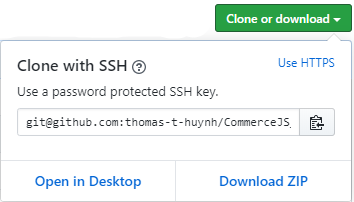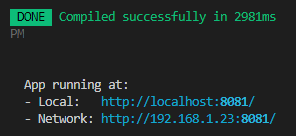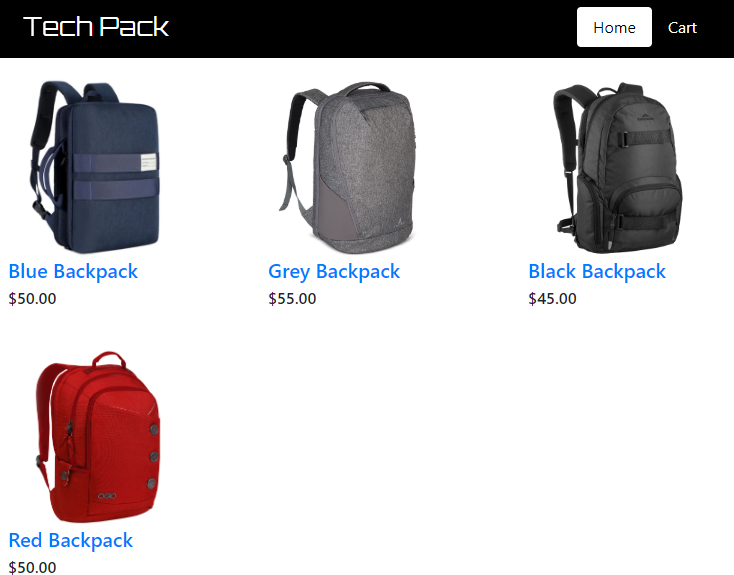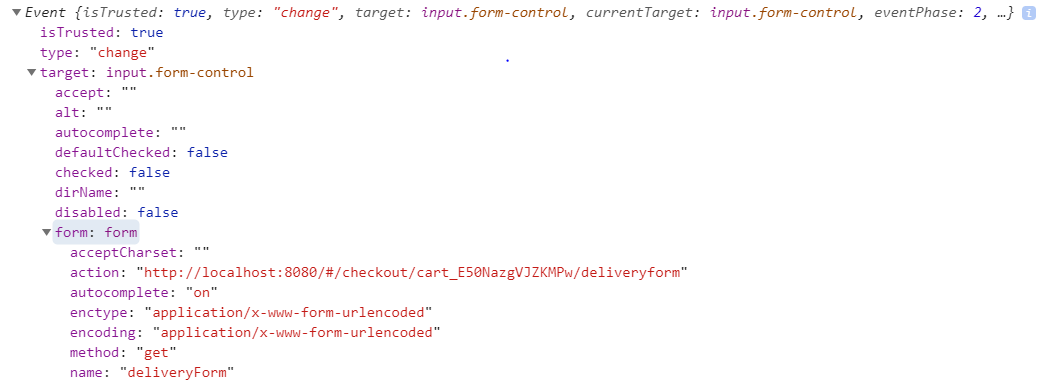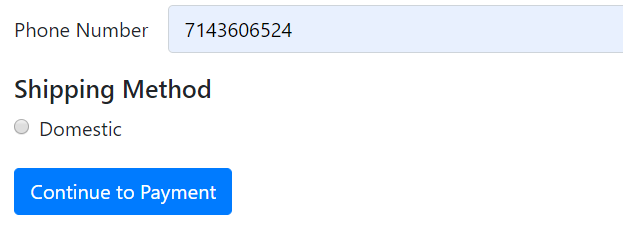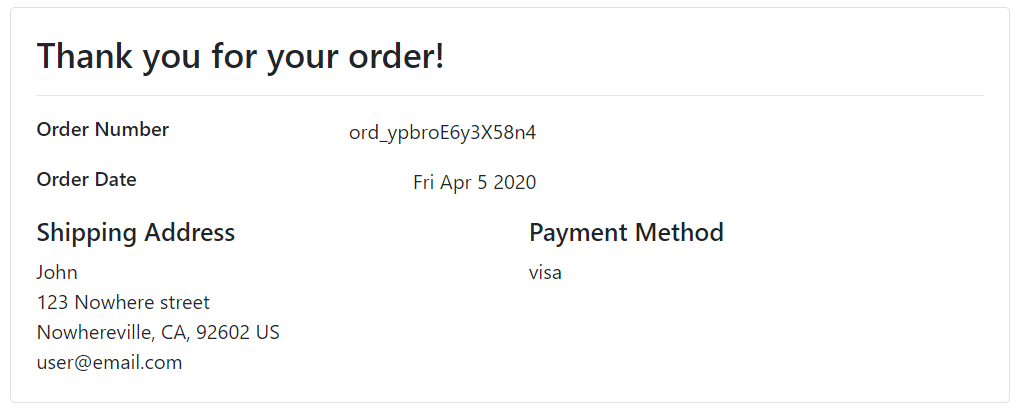This guide will take you through the checkout process for an eCommerce site using Commerce.js and Vue.js. The checkout process gives the vendor information on where to deliver the product, and on how they will charge the customer. At the end of the process, an order confirmation is shown to verify the purchase and to summarize details about the order.
Commerce.js v2 will be used in this guide.
This is a continuation of the example Adding Products to Cart with Commerce.JS using Vue.js, and this guide.
If you haven’t done so already, create an account so you can access the Chec Dashboard and add products through your dashboard. In this guide, backpacks (instead of car rims) will be the demo products used.
This guide will cover:
- Cloning and installing the base project.
- Generating a checkout token to set up form fields
- Using the Commerce.js ‘live’ object to dynamically render the order summary
- Handling delivery form and payment form logic
- Capturing a token and then showing the order confirmation
- IDE Code Editor
- NPM or yarn
- Vue JS
- Bootstrap
- Git
- Basic web development knowledge in HTML, CSS, and JS
- Some knowledge Single-page application design
First, visit the base repo page
Fork your own repository.
Clone or download the repo. This setup will go down the cloning path so copy the link shown in the popover.
Open a terminal of your choice, find a directory to store your project, and then enter in git clone clone-url.
git clone [email protected]:thomas-t-huynh/CommerceJS_How_to_handle_Checkout_VueJS_BASE.git
CD into the directory.
Cd CommerceJS_How_to_handle_Checkout_VueJS_BASE
Run npm install to get all the required modules
Npm install
Start up development by running this script.
Npm run serve
Visit the localhost link shown in your terminal.
The app should look like this.
Access the cloned project directory with an IDE of your choice, and get ready to code!
Buying a product online requires a large amount of information so it could arrive accurately to your doorstep. The checkout process requires info in specific formatting for some fields such as email or country. Thankfully, there are Commerce.js methods that could help set up some form data.
Starting off, visit the CartPage.vue. There should be a method called pushToCheckoutPage attached to the checkout button in the template. The method itself is this.
// CartPage.vue
pushToCheckoutPage() {
this.$router.push(`/checkout/${this.cart.id}`);
}When a user clicks this button, it will send them to the checkout page with the delivery form on it. Passing cart id as a parameter primarily serves to get the checkout token, but it will also persist the checkout process if the page happens to refresh or if the user wants to return to the checkout page.
Before working on the checkout page, go into App.vue and pass down commerce and checkoutToken as props into the router-view for the checkout page later on.
<!-- App.vue -->
<router-view ... :commerce="commerce" checkoutToken="checkoutToken" />First prop is the Commerce.js Object. The SDK will be used very often during the checkout process, and it can be completely managed by CheckoutPage.vue. This will prevent multiple levels of emitting, and all checkout logic will modularize in one file.
A quick brush up on emitting. Emitting is a way for a child component to pass data up to the parent component. The child component does this by using the built-in emit method, and passes in a string argument to represent the name of the event.
this.$emit("eventName")
The parent component listens for the string that's passed in, and calls the function assigned to the listener to handle the event. The event listener is binded to the child component in the parent file.
<!-- ParentFile.vue -->
<ChildComponent @eventName="handlerFunction" />Second prop is the checkout token. The checkout token is not generated yet so the following steps will cover that.
You'll be using a Vue property method called Watcher. A watcher behaves the way its name implies, it will watch for changes in a specified data state or prop and then respond with its assigned code.
// App.vue
watch: {
cart(newCart, oldCart) {
if (newCart.line_items.length > 0) {
this.generateToken(this.cart.id);
}
}
},The function is named after the prop or data you want to watch, and the parameters have access to the previous data and the new data. This function checks if the updated cart object has one or more items in the cart. If so, it will call this.generateToken(), which is the code below. Copy and paste it into Methods.
// App.vue
generateToken(cartId) {
this.commerce.checkout
.generateToken(cartId, { type: "cart" })
.then(res => {
this.checkoutToken = res;
})
.catch(err => console.log(err));
},this.commerce.checkout.generateToken() can be called with a permalink, which is why the type has to be specified. The response from the call is a checkout token that contains its ID used for capturing the token, and to access built-in helper functions. The token is assigned to the data states.
With the App.vue now set up, the checkout page should be ready for some code. In the pages directory, create a file and name it CheckoutPage.vue. Copy and paste the code below to quickly get a basic layout.
<!-- CheckoutPage.vue -->
<template>
<div>
CheckoutPage
</div>
</template>
<script>
export default {
name: "CheckoutPage",
props: {
commerce: {
type: Object
},
checkoutToken: {
type: Object,
required: true
}
},
created() {}
};
</script>
<style scoped></style>This is a new route that’s not hooked up to the VueRouter yet. Navigate into main.js, import in CheckoutPage.vue, and add the object containing the new route’s properties.
//main.js
{
path: "/checkout/:id",
name: "CheckoutPage",
component: CheckoutPage,
}Test the route by clicking the secure checkout button in CartPage.vue.
With the CheckoutPage.vue now in place, it’s time to make use of the checkout token that was passed through.
Create default values in the component’s data method for the live token. In addition to that, make the properties for countries and states for the next steps.
// CheckoutPage.vue
data() {
return {
live: this.checkoutToken.live,
countries: {},
states: {},
};
},The live object holds ‘real-time’ data on the checkout total. Helper functions that check for tax or for available shipping can alter the total price of the checkout, and the live object returned form these functions can reflect these changes.
The following Commerce.js calls is why the created() method is in use. Asynchronous API calls have a delayed response so having these calls in created() ensures that their returned values will be rendered.
In CheckoutPage.vue, make a created() method, and then add the following block of code in.
// CheckoutPage.vue
created() {
this.commerce.services
.localeListCountries(this.checkoutToken.id)
.then(res => {
this.countries = { "": "Select a country", ...res.countries };
})
.catch(err => console.log(err));
this.commerce.services
.localeListSubdivisions("US")
.then(res => {
this.states = { "": "Select a state", ...res.subdivisions };
})
.catch(err => console.log(err));
}The responses should return objects of countries and subdivisions that can be shipped out to the current checkout. The concatenated objects shown above will serve only as display values for users to select a location. These returned objects will be assigned to the states you made earlier.
It's a good idea to grab the location data from Chec's API because it contains the locations that Chec supports, and the data is in a format that the API understands.
The delivery form will emit events on every keystroke, which could lead to a very dynamic form experience for users.
Create DeliveryForm.vue in the components folder, and then copy and paste this in.
<!-- DeliveryForm.vue -->
<template>
<form name="deliveryForm" @submit="onSubmit">
Delivery form
</form>
</template>
<script>
export default {
name: "DeliveryForm",
props: ["states", "countries"]
};
</script>
<style scoped></style>The name in the form will be useful later on to detect where the event is firing from.
Rather than rendering DeliveryForm.vue as a component, this guide will introduce nested routes.
Access the router in Main.js, import DeliveryForm.vue, and add an additional property named children that holds an array of route objects.
// main.js
{
path: "/checkout/:id",
name: "CheckoutPage",
component: CheckoutPage,
children: [
{
path: "deliveryform",
component: DeliveryForm
}
]
}Nested routing allows for rendering of a route within a route itself. This will make the checkout page similar to the App.vue page as it will host a router-view tag in its template too.
The way to access the child routes is by appending the child’s path at the end of the parent route’s path.
"/checkout/:id/deliveryform"
This means you will have to change the link in CartPage.vue.
// CartPage.vue
this.$router.push(`/checkout/${this.cart.id}/deliveryform`);Now travel back into the CheckoutPage.vue and add the router-view component into the template. Bind the countries and states data states as props.
// CheckoutPage.vue
<template>
<div>
<router-view :countries="countries" :states="states" />
</div>
</template>The delivery form should now be rendering when you visit the page!
The form will need input tags to allow users to enter in their info. Below is a large amount of templating html that is self-explanatory. Copy and paste it into the DeliveryForm.vue.
// DeliveryForm.vue
<h3>Customer</h3>
<div class="form-group row">
<label for="checkout-email" class="col-sm-2 col-form-label"
>Email address</label
>
<input
type="email"
class="form-control col-sm-10"
id="checkout-email"
name="email"
@change="onChange"
required
/>
</div>
<div class="form-group row">
<div class="col">
<label for="checkout-firstname">First name</label>
<input
type="text"
class="form-control"
name="firstname"
required
@change="onChange"
/>
</div>
<div class="col">
<label for="checkout-lastname">Last name</label>
<input
type="text"
class="form-control"
name="lastname"
required
@change="onChange"
/>
</div>
</div>
<h3>Delivery</h3>
<div class="form-group row">
<label for="checkout-recipient" class="col-sm-2 col-form-label"
>Recipient Name</label
>
<input
type="text"
class="form-control col-sm-10"
id="checkout-recipient"
name="recipient"
@change="onChange"
required
/>
</div>
<div class="form-group row">
<label for="checkout-street" class="col-sm-2 col-form-label"
>Street Address</label
>
<input
type="text"
class="form-control col-sm-10"
id="checkout-street"
name="street"
@change="onChange"
required
/>
</div>
<div class="form-group row">
<label for="checkout-optionalAddress" class="col-sm-2 col-form-label"
>Apt, Suite, etc. (Optional)</label
>
<input
type="text"
class="form-control col-sm-10"
id="checkout-optionalAddress"
name="optionalAddress"
@change="onChange"
/>
</div>
<div class="form-group row">
<label for="checkout-town_city" class="col-sm-2 col-form-label">Town/City</label>
<input
type="text"
class="form-control col-sm-10"
id="checkout-town_city"
name="town_city"
@change="onChange"
required
/>
</div>
<div class="form-group row">
<label for="checkout-zip_code" class="col-sm-2 col-form-label"
>Zip Code</label
>
<input
type="text"
class="form-control col-sm-10"
id="checkout-zip_code"
name="zip_code"
@change="onChange"
required
/>
</div>
<div class="form-group row">
<label for="checkout-states" class="col-sm-2 col-form-label">State</label>
<select
class="form-control col-sm-10"
id="checkout-states"
name="state"
@change="onChange"
:disabled="disableStates"
required
>
<option
v-for="(state, i) in Object.keys(states)"
:value="state"
:key="i"
>
{{ states[state] }}
</option>
</select>
</div>
<div class="form-group row">
<label for="checkout-country" class="col-sm-2 col-form-label"
>Country</label
>
<select
class="form-control col-sm-10"
id="checkout-country"
name="country"
@change="onChange"
required
>
<option
v-for="(country, i) in Object.keys(countries)"
:value="country"
:key="i"
>
{{ countries[country] }}
</option>
</select>
</div>
<div class="form-group row">
<label for="checkout-number" class="col-sm-2 col-form-label"
>Phone Number</label
>
<input
type="text"
class="form-control col-sm-10"
id="checkout-number"
name="number"
@change="onChange"
required
/>
</div>
<h5>Shipping Method</h5>
<div v-for="method in shippingMethods" :key="method.id" class="form-check">
<input
class="form-check-input"
type="radio"
name="shipping_method"
:value="method.id"
@change="onShippingChange"
required
/>
<label class="form-check-label" for="exampleRadios1">{{
method.description
}}</label>
</div>
<p v-if="shippingMethods.length === 0">No shipping methods currently available.</p>
<button class="btn btn-primary">Continue to Payment</button>Most of the logic here is handled by HTML attributes and tags. You can think of them as settings you can change. Some of the more notable HTML features found here are Type, Required, Name, and Select.
The state and countries inputs will be using the state you made earlier. The state input will be used as an example below.
// DeliveryForm.vue
<select
class="form-control col-sm-10"
id="checkout-states"
name="state"
@change="onChange"
:disabled="disableStates"
required
>
<option
v-for="(state, i) in Object.keys(states)"
:value="state"
:key="i"
>
{{ states[state] }}
</option>
</select>The v-for directive iterates through each item in an array. Although States isn’t an array, the Object.keys() method takes all the keys of the object passed through and returns it as an array. This allows you to use the keys as values (state codes for Commerce.js SDK) and use the actual values (readable state values) for users to select.
The disabled attribute contains a boolean value return from a computed function in the checkout page. It checks if the country is “US” and if it is, it will return true so the states of the US can be selected.
// CheckoutPage.vue
computed: {
disableStates() {
return this.deliveryForm.country === "US" ? false : true;
}
},Pass down that computed value along with the rest of the required props and event handlers that is shown below.
<!-- CheckoutPage.vue -->
<router-view
...
@onChange="handleOnChange"
@onShippingChange="setShippingMethod"
@onSubmit="handleOnSubmit"
:disableStates="disableStates"
:shippingMethods="shippingMethods"
/>Some of these onChange events will need states to assign to so make sure to add the states in the data.
// CheckoutPage.vue
data() {
return {
checkoutToken: {},
live: {},
countries: {},
states: {},
shippingMethods: [],
deliveryForm: {
country: ""
},
};
},Each field has a @change=”onChange” event emitter so it can communicate with the parent component CheckoutPage.vue. It passes up an event object, which will be used to collect the input’s value. Below are the methods that will handle the onChange events. Make sure these are included.
// DeliveryForm.vue
methods: {
onChange(e) {
this.$emit("onChange", e);
},
onShippingChange(e) {
this.$emit("onShippingChange", e.target.value);
},
onSubmit(e) {
this.$emit("onSubmit", e);
}
},
props: ["disableStates", "states", "countries", "shippingMethods"]Now you’ll create methods that will handle the change events being emitted. First off will be the handler for input changes.
// CheckoutPage.vue
handleOnChange(e) {
const { form, name, value } = e.target;
this[form.name][name] = value;
form.name === "deliveryForm" && this.updateCheckoutSubtotal();
},Whenever there’s a change in the input field with onChange bound to it, it will find the property in the delivery form state you created earlier via bracket notation. The e parameter passed through is the event object that can be accessed from the onChange attribute. It contains the name of both the form and the input it came from.
In case you have forgotten, the form in DeliveryForm.vue has a name attribute on it.
<!-- DeliveryForm.vue -->
<form name="deliveryForm" @submit="onSubmit"></form>If you're curious about what else e has to offer , console log it to see.
Next method will be the one inside handleOnChange() at the last line, updateCheckoutSubtotal().
// CheckoutPage.vue
updateCheckoutSubtotal() {
if (this.deliveryForm.country) {
const { country, zip_code, state } = this.deliveryForm;
if (
this.deliveryForm.country === "US" &&
this.deliveryForm.zip_code &&
this.deliveryForm.state
) {
this.checkShippingAndTax(country, zip_code, state);
} else {
this.checkShippingAndTax(country);
}
}
},This method checks if certain fields of the form data is filled. If it is filled, It will activate another function that will use the Commerce.js helper functions to grab tax and shipping prices based on the location fields. US locations require additional information to grab tax and shipping prices. This function is called during onChange so it can update the form and order summary in real time.
Moving on to the next method that gets called inside of the previous one, checkShippingAndTax().
// CheckoutPage.vue
checkShippingAndTax(country, zip_code = "", state = "") {
this.commerce.checkout
.setTaxZone(this.checkoutToken.id, {
postal_zip_code: zip_code,
country: country,
region: state
})
.then(res => {
this.live = res.live;
})
.catch(err => console.log(err));
this.commerce.checkout
.getShippingOptions(this.checkoutToken.id, {
country: country,
region: state
})
.then(res => {
this.shippingMethods = res;
})
.catch(err => {
this.shippingMethods = []
});
}
},This method uses Commerce.js methods to grab updated shipping and tax prices based on user inputted location. A live object will return from the setTaxZone() call. Assign the live state to the live object so it can update the order summary later on. The getShippingOptions() method will return an array of available shipping methods. Assign this to the shippingMethods state so it can be used in the delivery form. The shipping method form will appear and look like this if shipping options available.
All the fields in the delivery form use the onChange() method, but only the shipment selection has its own method onShippingChange(). The next method setShippingMethod() will respond to this event emitter.
// CheckoutPage.vue
setShippingMethod(shippingId) {
this.commerce.checkout
.checkShippingOption(this.checkoutToken.id, {
shipping_option_id: shippingId,
country: this.deliveryForm.country,
region: this.deliveryForm.state
})
.then(res => {
this.deliveryForm.shipping_method = res.id;
this.live = res.live;
})
.catch(err => console.log(err));
}The method will take the shipment ID passed from the delivery form and then use that to make a Commerce.js method call checkShippingOption() to verify if the shipping option is valid. A live object is returned in the call and if the shipping is valid, it will update the live object. Assign shippingId to the deliveryForm.shipping_method property and the returned live object response to the live state.
// CheckoutPage.vue
handleOnSubmit(e) {
e.preventDefault();
if (this.deliveryForm.shipping_method) {
this.$router.push(`/checkout/${this.$route.params.id}/paymentform`);
} else {
this.status = "Delivery must have a shipping method.";
document.getElementById("OrderSummary").scrollIntoView();
}
}The last method handles the onSubmit emit. It pushes the user to the payment form route. The prevent default method for the event object stops the usual effect of page refreshing when forms are submitted. The reload is unnecessary, causes slowdowns in user experience, and erases state data that will be used later.
It also checks if the shipping method property on the delivery form is filled out. If there's none, a status message will be assigned and then revealed to the customer. A shipping method is required because the store can't ship to a location it doesn't supply to.
The delivery form should now be complete!
An order summary keeps track of the order’s pricing as the customer progresses through the checkout process. Based on how the delivery form is set up earlier, the returned values from the Commerce.js helper functions can dynamically update the order summary with the use of the live object.
Create OrderSummary.vue in the components folder, and then copy and paste this code below to get a quick start.
<!-- OrderSummary.vue -->
<template>
<div class="card orderSummary-card">
<div class="card-body">
<h4 class="card-title">Order Summary</h4>
<hr />
<OrderSummaryItem
v-for="item in live.line_items"
:item="item"
:key="item.id"
/>
<hr />
<div class="d-flex justify-content-between">
<p>Subtotal</p>
<p>{{ live.subtotal.formatted_with_symbol }}</p>
</div>
<div class="d-flex justify-content-between">
<p>Shipping</p>
<p>{{ live.shipping.price.formatted_with_symbol }}</p>
</div>
<div class="d-flex justify-content-between">
<p>Tax</p>
<p>{{ live.tax.amount.formatted_with_symbol }}</p>
</div>
<hr />
<div class="d-flex justify-content-between">
<h5>Total with Tax</h5>
<h5>{{ live.total_with_tax.formatted_with_symbol }}</h5>
</div>
</div>
</div>
</template>
<script>
import OrderSummaryItem from "./OrderSummaryItem";
export default {
name: "OrderSummary",
props: ["live"],
components: {
OrderSummaryItem
}
};
</script>
<style>
.orderSummary-card {
margin: 20px 0;
}
</style>The order summary is a simple component that renders the props it receives from the checkout page. There is another component that needs to be made for this file called OrderSummaryItem.vue.
Create OrderSummary.vue in the components folder, and copy and paste this code in.
<!-- OrderSummary.vue -->
<template>
<div class="d-flex justify-content-between">
<div>
<h6>{{ item.product_name }}</h6>
<p>Quantity: {{ item.quantity }}</p>
</div>
<p>{{ item.line_total.formatted_with_symbol }}</p>
</div>
</template>
<script>
export default {
name: "OrderSummaryItem",
props: ["item"]
};
</script>
<style></style>This component will list out the items in the user’s cart. Users can double check the items they have in the cart during the checkout, and see if the prices change accurately.
Return to CheckoutPage.vue, import the component, and list it in the components method.
// CheckoutPage.vue
import OrderSummary from "../components/OrderSummary";
export default {
name: "CheckoutPage",
components: {
OrderSummary
},Add it into the template right above the delivery form component.
<!-- CheckoutPage.vue -->
<OrderSummary v-if="”live”" :live="live" id="OrderSummary" />
<router-view ... />The v-if directive checks if the live object exists. Remember how the default value for the live state was set as undefined? The order summary will only render if the live object is collected from the Commerce.js calls. The component can render regardless of this directive, but it will yield warnings and errors that clouds up the console because the component will attempt to read properties from undefined props initially.
The id is assigned to order summary so the page can scroll up if any error messages appear.
The order summary should turn out like this image above. The shipping and tax information updates as the live object gets updates from the delivery form methods.
The next form in this guide is the payment form, a way for users to securely pay for the products online. The payment form takes in three values: the card number, the card expiration, and the CVC. While it's fundamentally the same as the delivery form, the payment form has extra steps because it has to properly validate card numbers.
Before creating the component, hook up the component in the router at main.js. Although the file is not yet made, import it in too so you don't have to go back and forth.
// main.js
import PaymentForm from "./components/PaymentForm.vue";
...
{
path: "/checkout/:id",
name: "CheckoutPage",
component: CheckoutPage,
children: [
{
path: "deliveryform",
component: DeliveryForm
},
{
path: "paymentform",
component: PaymentForm
}
]
}
Create PaymentForm.vue in the components folder and then copy and paste this code below.
<!-- PaymentForm.vue -->
<template>
<form name="paymentForm" @submit="onSubmit">
<h3>Payment Method</h3>
<div class="form-group">
<label for="checkout-number">Card Number</label>
<input
type="text"
class="form-control"
id="checkout-number"
name="number"
required
@change="onChange"
/>
</div>
<div class="row">
<div class="col">
<label for="checkout-cardNumber">Expiration Date MM/YY</label>
<input
type="text"
class="form-control"
name="expire"
required
@change="onChange"
pattern="([0-9]{2}[/]?){2}"
/>
</div>
<div class="col">
<label for="checkout-cardNumber">CVC ###</label>
<input
type="text"
class="form-control"
name="cvc"
required
@change="onChange"
pattern="([0-9]{3})"
/>
</div>
</div>
<button class="btn btn-primary">Submit Order</button>
</form>
</template>
<script>
export default {
name: "PaymentForm",
methods: {
onChange(e) {
this.$emit("onChange", e);
},
onSubmit(e) {
this.$emit("onSubmit", e);
}
}
};
</script>
<style scoped>
form {
margin: 20px 0;
}
button {
margin: 20px 0;
}
</style>This is a very similar file compared to the delivery form. The main difference is the pattern attribute found for the expiration date field and the CVC field.
<!-- PaymentForm.vue -->
<input
type="text"
class="form-control"
name="expire"
required
@change="onChange"
pattern="([0-9]{2}[/]?){2}"
/>The pattern attribute can accept a regex string so it can detect if the user’s input follows proper format. Explaining regex will take you down a deep rabbit hole so it will not be explained thoroughly in this guide. The regex strings are included in the code above.
Back inside of CheckoutPage.vue, you’ll install a credit card number validator library so your payment form can verify card numbers. If you want to understand the algorithm used to determine valid card numbers, check out the Luhn’s algorithm.
To install, open the temrinal and enter.
npm install creditcard.js
Import the package into CheckoutPage.vue.
// CheckoutPage.vue
import CreditCard from "creditcard.js";Then create a state so it can hold the validator object. Also add the three additional states below. They will be explained shortly.
// CheckoutPage.vue
data() {
return {
...
validator: new CreditCard(),
paymentForm: {},
status: "",
receipt: {}
...
}
},Now for the handleOnSubmit() method. Replace the one that’s currently in the payment form with this one.
// PaymentForm.vue
handleOnSubmit(e) {
e.preventDefault();
if (
e.target.name === "deliveryForm" &&
this.deliveryForm.shipping_method
) {
this.status = "";
this.$router.push(`/checkout/${this.$route.params.id}/paymentform`);
} else if (e.target.name === "paymentForm") {
const isValidated = this.validator.isValid(this.paymentForm.number);
if (isValidated) {
this.status = "";
const spacedNumber = this.paymentForm.number.replace(
/(\d{4}(?!\s))/g,
"$1 "
);
const splitExpire = this.paymentForm.expire.split("/");
this.handleCapture(spacedNumber, splitExpire[0], splitExpire[1]);
} else {
this.status = "The card number you entered is invalid.";
}
} else {
this.status = "Delivery must have a shipping method.";
document.getElementById("OrderSummary").scrollIntoView();
}
},This is the same handleOnSubmit() you had to copy earlier, but with some changes. The code checks which form is the submit event coming from. If it’s the payment form, it will run the validator you just installed. If the validator returns true, the card is good for transactional use. You will encounter some more regex once again. For the sake of brevity, the regex adds a space between every 4 digts in the card number. While it’s good to learn regex if you plan to create complex pattern matching, there are plenty of premade regex patterns that can be found with a quick Google search for quicker development.
The const splitExpire separates the month and years on the expire property of the paymentForm state. Split takes in a string argument so it can seperate a string into elements in an array based on where the argument exists in the string. Ie: “12/20” returns as [ “12”, “20” ].
The point of changing these string values is because the Commerce.js SDK can only take them in this format during the token capture. At the end of this method, the formatted values are passed into another method handleCapture() for later use.
The conditional logic with the status states will notify users whether their card number is valid or not. Add this element into the template. It only appears if the status state is not an empty string.
<!-- CheckoutPage.vue -->
<div v-if="status" class="alert alert-danger fade show" role="alert">
{{ status }}
</div>// CheckoutPage.vue
handleCapture(number, month, year) {
let line_items = {};
this.live.line_items.forEach(item => {
line_items[item.id] = { quantity: item.quantity };
});
const d = this.deliveryForm;
const p = this.paymentForm;
const data = {
line_items,
customer: {
firstname: d.firstname,
lastname: d.lastname,
email: d.email
},
shipping: {
name: d.recipient,
street: d.street,
town_city: d.town_city,
county_state: d.state,
postal_zip_code: d.zip_code,
country: d.country
},
fulfillment: {
shipping_method: d.shipping_method
},
payment: {
gateway: "test_gateway",
card: {
number: number,
expiry_month: month,
expiry_year: year,
cvc: p.cvc,
postal_zip_code: d.zip_code
}
}
};
this.commerce.checkout
.capture(this.checkoutToken.id, data)
.then(res => {
this.receipt = res;
this.$router.push(`/checkout/${res.id}/confirmation`);
this.$emit("getNewCart");
})
.catch(err => {
console.log(err)
});
}This code will use the Commerce.js to capture the checkout, which will finalize the purchase and then return order data.
Line_items data must be passed in as an object. The first few lines of code handles this conversion. Using a concept called Macros, you can shorten this.paymentForm and this.deliveryForm to a single letter for ease of variable referrence. In this case, you’ll be using d and p.
The data object above shows all the required properties. The number, month, and year were passed in from the previous method. You’ll be using the ‘test_gateway’ for testing purposes.
One more detail to add is when making test checkouts, you will have to use this card number "4242424242424242”. This is a valid dummy number given by the Commerce.js documentation that can simulate a valid capture.
The SDK makes a call to the server with the data object, and if successful, will return an object assigned to the receipt, which will be used for making the confirmation component. The $router.push sends users to the confirmation nested route, and then an emit to App.vue will signal a method to clear out the user’s cart.
In App.vue, create the emit handler.
<!-- App.vue -->
<router-view ... @getNewCart="handleGetNewCart" />And the method to handle it.
App.vue
handleGetNewCart() {
this.commerce.cart
.retrieve()
.then(res => {
this.cart = res;
})
.catch(err => console.log(err));
}If you had your debugger on, it will notify you in the console that a new cart is made. This method makes a call after the capture is successful so it can grab that newly-made empty cart for the user. This clears the previous cart the user had.
The receipt state that receives the object returned from a successful capture contains information for the order confirmation component. This third nested component will contain all the information about the order such as the shipping address, the type of credit card used, and the order ID just to name a few.
Create Confirmation.vue in the component folder, and then copy and paste this code in.
<!-- Confirmation.vue -->
<template>
<div class="card">
<div class="card-body">
<h3 class="card-title">Thank you for your order!</h3>
<hr />
<div class="confirmation-order_info">
<div class="d-flex justify-content-between">
<h6>Order Number</h6>
<p>{{ receipt.customer_reference }}</p>
</div>
<div class="d-flex justify-content-between">
<h6>Order Date</h6>
<p>
{{ moment().millisecond(receipt.created/1000).format("ddd MMM D
YYYY") }}
</p>
</div>
</div>
<div class="row">
<div class="col">
<h5>Shipping Address</h5>
<p>{{ receipt.shipping.name }}</p>
<p>{{ receipt.shipping.street }}</p>
<p>
{{ receipt.shipping.town_city }}, {{
receipt.shipping.county_state}}, {{ receipt.shipping.postal_zip_code
}} {{ receipt.shipping.country }}
</p>
<p>{{ receipt.customer.email }}</p>
</div>
<div class="col">
<h5>Payment Method</h5>
<p>{{ receipt.payments[0].card_type }}</p>
</div>
</div>
</div>
</div>
</template>
<script>
import moment from "moment";
export default {
name: "Confirmation",
props: {
receipt: {
type: Object
}
},
data() {
return {
moment: moment
};
}
};
</script>
<style scoped>
.card {
margin: 20px 0;
}
.confirmation-order_info {
width: 400px;
}
.row .col p {
margin: 0;
}
</style>This is another straightforward component that receives props. It does introduce one new tool that can aid you in all date-related development. The created property from the returned object is in milliseconds since the unix time. Using the moment library, you can quickly transform those milliseconds into a readable date.
Open the terminal and install moment.js
npm install moment
If you coppied the code above, the module is already imported and then added into the data state. Using the milliseconds method, it can take in integers in values of milliseconds and then return a date object. The format method then takes a string pattern (like a more simple regex), and then returns a date value using that format.
Next, add this subroute into main.js. Import and create the route object as usual.
// Main.js
import Confirmation from "./components/Confirmation.vue";
...
{
path: "/checkout/:id",
name: "CheckoutPage",
component: CheckoutPage,
children: [
{
path: "deliveryform",
component: DeliveryForm
},
{
path: "paymentform",
component: PaymentForm
},
{
path: "confirmation",
component: Confirmation
}
]
}Now pass down the receipt state in CheckoutPage.vue as props into router-view so the Confirmation.vue can make use of it.
<!-- CheckoutPage.vue -->
<router-view ... :receipt="receipt" />Fill out the forms to see if it all works. Make sure you use the dummy card number “4242424242424242”, and an email you own (to check if Chec's automated order confirmation email is intact). The component will appear after a few seconds, and will look like this.
And that wraps up the whole checkout process!
The checkout form by far takes the most time to develop due to all the variable changes that can occur based on customer input. There are many additional functions that could be incorporated into the checkout process, especially with a flexible SDK such as Commerece.js. Hopefully you now have a basic undertsanding of how to build a checkout form with Vue.js and continue to find other cool features to implement to make the checkout process more user friendly.
This guide is a continuation of a previous guide
NPM Vue.js Bootstrap Codesandbox
Thomas Huynh - Github

